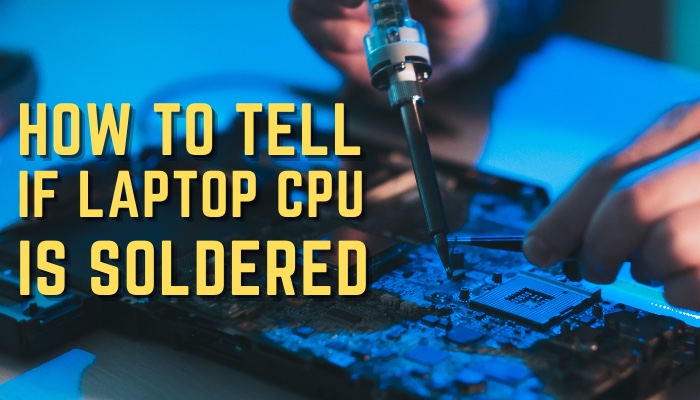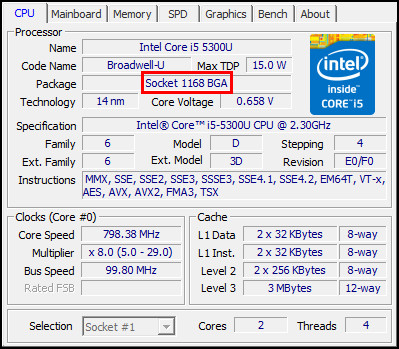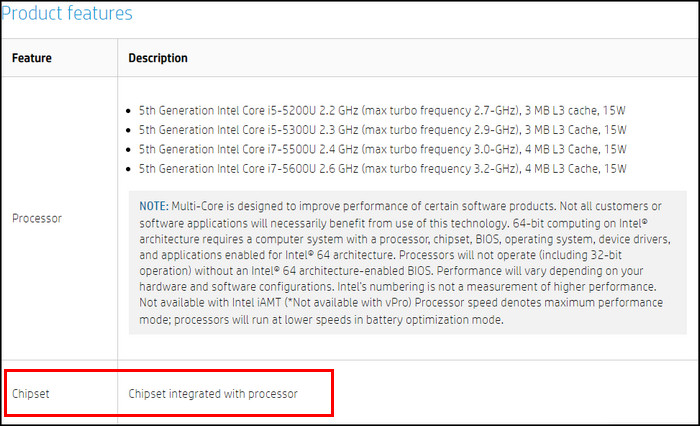Laptop designs are intended to be as portable as possible. Manufacturers often soldered the parts onto the motherboard to design a portable laptop.
The best way to tell if your laptop is soldered to the motherboard is by opening the laptop’s back panel. If you are unable to open up, you can use some workaround to accomplish the same.
This article will cover the methods to identify whether the laptop CPU is soldered. So let’s get started!
How to Know if Laptop CPU is Soldered
There are several ways to check whether a laptop CPU is soldered or detachable, such as checking the laptop documentation or looking for a CPU socket in your laptop. Besides, third-party applications like CPU-Z can show whether the CPU is soldered.
When the old laptops cannot perform at their full potential, you may want to change or upgrade the CPU for better performance. While you’re here, don’t forget to check out our discussion on what’s the good processor speed for laptops.
But before that, you must ensure your laptop CPU is detachable from your motherboard. Consider the following instruction to check if your laptop CPU is soldered.
Here are the ways to find out whether a CPU is soldered or not:
1. Look for a CPU Socket
A CPU socket is a component that connects the CPU to the motherboard. You should look for the CPU socket to identify whether your laptop CPU is soldered or detachable.
If you find a CPU socket on your laptop, then the CPU is removable. On the contrary, the CPU is soldered if you cannot locate the CPU socket on the motherboard.
2. Check the Documentation
Every product comes with some paperwork, such as a user manual. Find your user manual and search for the CPU information.
You should find some information about CPU technology. Once you find the CPU-related page, check whether the laptop CPU is soldered or separable.
3. Use Third-party Applications
Several third-party applications can read all hardware and software details like CPU-Z. Using this application, you can see the socket type of your laptop.
Open CPU-Z and locate Package under the Processor details. If you see BGA (Ball Grid Array) next to the socket model, then the CPU is soldered. On the other hand, if you find LGA or PGA, then the CPU is detachable. 
4. Search for Laptop Specifications
By searching with your laptop model number, you can check every detail of your laptop, including the CPU socket type.
Open your browser and type your laptop model number. Go to the manufacturer’s website and locate the Chipset details. Here, you will find the CPU socket type and determine whether the CPU is soldered or not. 
Why is the Laptop CPU Soldered?
The main reason behind the laptop CPU soldering is cost-cutting. People assume that the laptop CPU is soldered because the company wants to prevent the customers from replacing the components. However, there are other reasons why manufacturers use soldering.
CPU soldering makes the device thinner with reduced manufacturing costs. Soldering makes it harder to replace the CPU and encourages people to buy a new one.
Check the following reason behind the laptop’s soldered parts:
Demand Less Space
When the laptop parts are soldered to the motherboard, it demands less space, and designers have more options to design a slimmer laptop.
In addition, a soldered part requires less space and components compared to the CPU socket. It allows the manufacturer to put more pieces into the motherboard.
Less Failure Rate
Soldered parts are comparatively more durable than removable parts. Detachable parts require more components and wires to connect. Connecting parts and wires can fail, and it increases the failure rate.
Extra components also increase the cost of production. Hence, the soldered CPUs are more budget-friendly and have a significantly low failure rate.
Easier to Assemble
Generally, laptops are built in large batches. More components mean more work for assembly. It increases the cost and takes more time.
That’s why laptop manufacturers opt for soldered CPUs rather than removable components. It’s also why you can’t use a laptop CPU on a desktop.
Is it Possible to Replace a Soldered CPU?
Yes, you can replace a soldered CPU. A soldered CPU is connected to the motherboard with numerous pins. You can disconnect the CPU pins and affix a new CPU by soldering the CPU pins to the motherboard if you have the technical knowledge and the right equipment.
Removing a soldered CPU is challenging because you may damage the CPU or motherboard while taking out the processor.
Besides, finding out a compatible CPU for your motherboard is another challenge. Most of the old motherboards may not support the latest powerful processors.
Besides, finding out a compatible CPU for your motherboard is another challenge. Most of the old motherboards may not support the latest powerful processors.
So, it’s worth buying a new laptop instead of replacing your existing CPU.
Check our latest post on how to Laptop CPU Vs Desktop CPU.
Frequently Asked Questions
Are all laptop CPUs soldered?
No, all laptop CPUs are not soldered. However, most laptop CPUs are soldered, and you cannot detach the CPU from the motherboard. In recent years, most laptop manufacturers also soldered RAM and hard drives.
How do I know if my laptop processor is upgradeable?
You can quickly identify whether the CPU is upgradeable by looking at the socket type. If your laptop processor has LGA or PGA sockets, you can upgrade the processor. Contrarily, if the laptop has a BGA socket, you may not upgrade it.
Can I change the CPU on my laptop?
If your laptop has a detachable CPU, you can quickly change it without difficulty. However, if the CPU is soldered on the motherboard, you will not be able to change it.
Final Thoughts
Identifying the CPU socket type provides information about the technology used for connecting the processor to the motherboard.
Using any method described earlier in this article, you can quickly check if the CPU is soldered. Besides, I also cover the process of upgrading a soldered CPU.
I hope this article answers all your queries. However, you can leave a comment below for further assistance.




